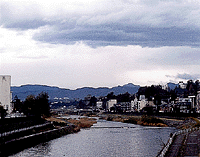The Maeda family
is an integral part of Kanazawa's history. The cultural
city, known as the "Million Koku of Kaga",
was built by successive generations of Maeda lords. One
could almost say that the Maeda family's history is Kaga's
or Kanazawa's history.
First, let's look at what, exactly, the Million Koku
of Kaga is. "Koku-daka" indicates the
wealth of the region over which a daimyo (a lord in old
Japan) ruled. A "koku" is about 180 litres and
was used primarily as a measure of rice. These days the currency
is backed by gold, but in the Edo era it was backed by
rice. Rice could be exchanged for money, so the financial power
of a region was determined by the amount of rice it harvested.
Of all the daimyo domains, the Kaga domain was
by far the wealthiest. Incidentally, the Edo Shogunate's
lands produced eight million koku, which indicates its
financial power. A person was called a daimyo if he produced
over ten thousand koku per year, so there were many vassals
in the Kaga domain who reached the daimyo class.
One can imagine, then, how great the Kaga domain was.
Kanazawa is known for Kutani and Ohi
ceramics, Kaga Yuzen (printed silk), Kaga
Mizuhiki (stiff ribbons made into various shapes for
decoration), Kaga Makie (a lacquer ware technique
in which metal powder is sprinkled on wet lacquer) and Kaga
Zogan (works with inlays of various materials). These
famous traditional handicrafts of Kanazawa took shape
under successive generations of Maeda lords. They did
not materialize overnight. In fact, history shows us that a lot
of time and effort went into developing these crafts.
The Maeda family ruled the entire Hokuriku district
for about three hundred years. Their rule spanned fourteen generations,
beginning in 1583, when Maeda Toshiie moved into
the Kanazawa castle from Nanao, Noto Province,
and ending with the rule of Yoshiyasu. Toshiie
served as one of the Five Great Elders under Toyotomi's
reign and earned enough trust to become the guardian of Hideyori
(Hideyoshi's son) after Toyotomi Hideyoshi's death.
Toshiie died in 1599, at the age of sixty-two, at Osaka
Castle.
After Toshiie's death the Maeda family worked
hard to secure the welfare of their family, sparing no efforts
to gain favour with the Shogun, Tokugawa Ieyasu.
They devoted themselves to the conservative policy of self-effacement,
in an attempt to maintain Kaga as the Million-Koku
domain.
In 1600, the second Maeda lord, Toshinaga,
fought in the Battle of Sekigahara in the eastern army,
on the Tokugawa side, and sent his mother to Edo to be
held as a guarantee of his loyalty. He also arranged a marriage
between his adopted son and heir, Toshitsune, and Tamahime,
the daughter of the second Tokugawa Shogun, Hidetada.
Thus began the political strategy of marriage with the Tokugawa
family.
Toshitsune, the third Maeda lord, in turn arranged
a marriage between his son and heir, Mitsutaka, and the
adopted daughter of Tokugawa Iemitsu (the third
Shogun). She was actually the natural daughter of Yorifusa
Tokugawa, of the Mito Tokugawas.
As the connections with the Tokugawa family deepened,
the Maedas visited Kyoto more and more frequently,
and inevitably developed an interest in the handicrafts of Kyoto.
They subsequently invited many master craftsmen from Kyoto,
and encouraged the development of arts and crafts across the
whole domain. This was purely a strategy to dispel the Shogunate's
wariness of the Maeda family. This cultural policy was
most successful during the time of Tsunanori, the fifth
Maeda lord.
For the Maedas, taking an interest in the arts and
crafts and throwing their financial power in that direction was
probably humiliating in one sense. However, by doing this they
built the foundations upon which cookery and food-related culture
would develop. When one considers this, the Maeda family's contribution
to Japanese cuisine is immeasurable.

